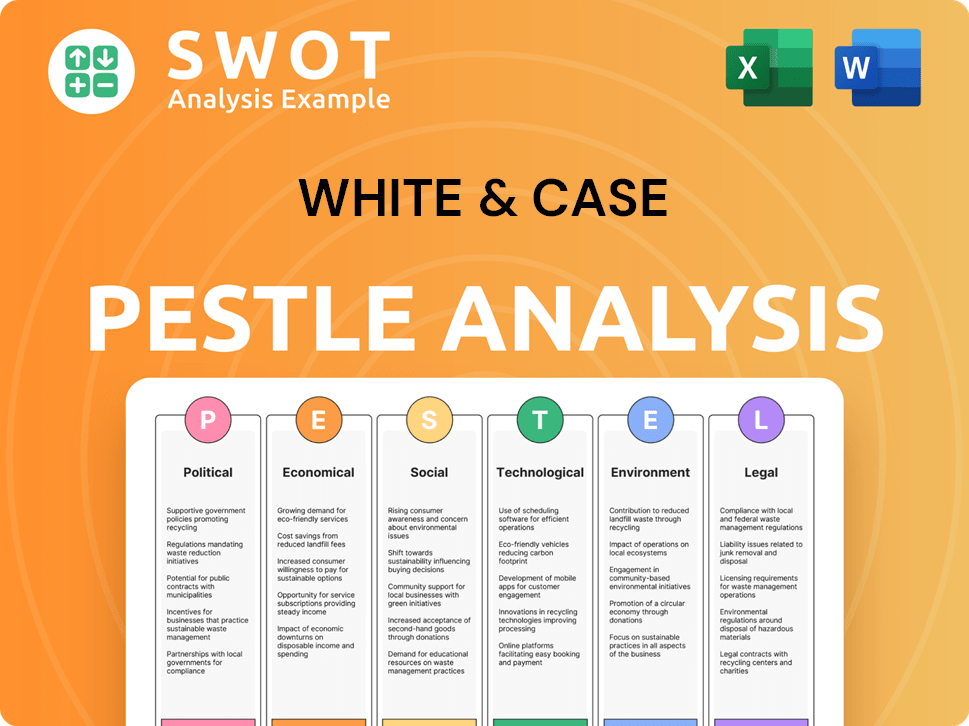White & Case Bundle
How Did White & Case Become a Global Legal Giant?
Journey back in time to uncover the remarkable White & Case SWOT Analysis, a law firm that has redefined the legal landscape. From its humble beginnings in New York City, White & Case has consistently demonstrated a visionary approach, especially in its early embrace of international expansion. Discover how this strategic foresight propelled them to the forefront of the global legal industry.

The White & Case history is a testament to strategic vision and adaptability within the legal industry. Founded in 1901, the White & Case law firm quickly recognized the importance of international commerce, setting the stage for its future as one of the leading global law firms. This article delves into the key milestones and innovations that have shaped White & Case's impressive trajectory, offering insights into its enduring success.
What is the White & Case Founding Story?
The story of White & Case begins on May 1, 1901. The firm's founders, Justin DuPratt White and George B. Case, saw an opportunity in the burgeoning financial landscape of New York City. Their combined expertise in corporate law and litigation laid the foundation for what would become a global legal powerhouse.
White & Case's early success was rooted in its ability to provide sophisticated legal services to banks, corporations, and financial institutions. The firm's straightforward name reflected its commitment to directness and partnership. The firm's initial funding came from the founders themselves, who leveraged their networks to secure early clients.
The firm's focus on high-value corporate and financial work helped it navigate the competitive legal market of the early 20th century. The Progressive Era's industrial expansion and financial complexity shaped the firm's initial focus on corporate law. Understanding the Marketing Strategy of White & Case offers insights into how the firm has sustained its growth over the years.
White & Case, a prominent name in the legal industry, was established in 1901 by Justin DuPratt White and George B. Case.
- Founding Date: May 1, 1901.
- Founders: Justin DuPratt White (corporate and financial law) and George B. Case (litigation).
- Initial Focus: Providing legal services to banks, corporations, and financial institutions.
- Early Client: Bankers Trust Company, a pivotal relationship.
White & Case SWOT Analysis
- Complete SWOT Breakdown
- Fully Customizable
- Editable in Excel & Word
- Professional Formatting
- Investor-Ready Format

What Drove the Early Growth of White & Case?
The early years of White & Case saw significant growth, fueled by a strategic focus on finance and international markets. The White & Case law firm quickly became a trusted advisor for major financial institutions. This early success set the stage for its future as a global legal leader. The firm's ability to anticipate market needs, especially the increasing globalization of commerce, was key.
Initially advising Bankers Trust Company, White & Case rapidly expanded its client base. This expansion included other prominent banks and corporations. This solidified its position in the burgeoning financial industry. This growth was crucial for establishing its reputation in the legal industry.
The firm's initial team grew steadily, reflecting increasing workload and client demand. Leadership transitions occurred organically as the firm expanded. New partners rose through the ranks to guide its expansion, shaping the White & Case history.
White & Case made an early move into international markets, opening its first overseas office in Paris in 1926. This pioneering step distinguished it from many domestic competitors. This early international presence allowed the firm to capitalize on cross-border transactions. This also helped in advising clients on complex international legal matters.
The firm's early success can be attributed to its ability to anticipate market needs. It recognized the increasing globalization of commerce. Its commitment to providing high-quality legal services was also a key factor. This strategic foresight significantly shaped White & Case's trajectory. You can learn more about the firm's business model by reading Revenue Streams & Business Model of White & Case.
White & Case PESTLE Analysis
- Covers All 6 PESTLE Categories
- No Research Needed – Save Hours of Work
- Built by Experts, Trusted by Consultants
- Instant Download, Ready to Use
- 100% Editable, Fully Customizable

What are the key Milestones in White & Case history?
The White & Case law firm has achieved several significant milestones throughout its history, shaping its evolution into a leading global legal practice. Its journey is marked by strategic decisions and expansions that have solidified its position in the legal industry.
| Year | Milestone |
|---|---|
| 1901 | White & Case was founded in New York City, marking the beginning of its journey in the legal industry. |
| 1926 | Opened its Paris office, becoming the first American law firm to establish a presence in Paris, a pioneering move in international expansion. |
| 1970s-1990s | Expanded its global footprint significantly by opening offices in major financial centers worldwide, including London, Tokyo, and Hong Kong. |
| 2000s | Continued its expansion through strategic mergers and acquisitions, enhancing its capabilities and reach in various practice areas. |
| 2023 | Reported a 13.6% increase in gross revenue, reaching $2.95 billion, demonstrating its financial strength and market resilience. |
White & Case has consistently demonstrated innovation, particularly in its approach to global expansion and service delivery. The firm's early commitment to international presence set a precedent in the legal industry.
White & Case was a pioneer in establishing a global network of offices, allowing it to serve clients across multiple jurisdictions. This strategy enabled the firm to offer comprehensive legal services on cross-border transactions and disputes.
The firm developed deep expertise in handling complex cross-border transactions and international legal matters. This specialization has been a key differentiator, attracting clients with global operations.
White & Case has consistently adapted its service offerings to meet evolving market demands. This includes expanding into new practice areas and developing specialized expertise to serve clients effectively.
The firm has embraced technology to improve efficiency and client service. This includes implementing advanced legal technology solutions to manage cases and streamline operations.
White & Case prioritizes building strong relationships with its clients, understanding their needs, and providing tailored legal solutions. This client-centric approach has been crucial for its long-term success.
To maintain resilience, the firm strategically diversified its practice areas. This diversification helps to mitigate risks associated with economic fluctuations and changes in the legal landscape.
Despite its successes, White & Case, like other global law firms, has faced various challenges. These include economic downturns, competitive pressures, and the complexities of managing a global organization.
Economic recessions and market fluctuations have impacted client demand and profitability. The firm has had to adapt to changing economic conditions to maintain its financial stability.
Competition from other global law firms has been a constant challenge. White & Case has needed to differentiate itself through expertise, service quality, and innovation.
Managing a large, international organization with diverse legal cultures and practices requires significant effort. This includes ensuring consistent quality and service across all offices.
The legal industry is subject to constant changes in laws and regulations across different jurisdictions. White & Case must remain agile to adapt to these changes and advise clients effectively.
Attracting and retaining top legal talent is crucial for success in the legal industry. This requires a strong company culture, competitive compensation, and opportunities for professional development.
The firm must consistently uphold its reputation for excellence and integrity. This involves delivering high-quality legal services and maintaining strong ethical standards.
White & Case Business Model Canvas
- Complete 9-Block Business Model Canvas
- Effortlessly Communicate Your Business Strategy
- Investor-Ready BMC Format
- 100% Editable and Customizable
- Clear and Structured Layout

What is the Timeline of Key Events for White & Case?
The White & Case law firm boasts a rich history, marked by significant milestones that have shaped its global presence and reputation. Founded in 1901 in New York City, the firm quickly established itself as a leader in international law. Early successes paved the way for pioneering moves, including the opening of its first international office in Paris in 1926. Subsequent decades saw strategic expansions into Asia, the Middle East, and Eastern Europe, solidifying its position among the top global law firms.
| Year | Key Event |
|---|---|
| 1901 | Justin DuPratt White and George B. Case founded the firm in New York City. |
| 1926 | Opened its first international office in Paris, marking a pioneering move for an American law firm. |
| 1970s-1980s | Expanded significantly into Asia and the Middle East, establishing a broader global presence. |
| 1990s | Continued global expansion, opening offices in Eastern Europe following the fall of the Berlin Wall. |
| 2000s | Focused on strengthening its practices in emerging markets and key financial centers worldwide. |
| 2015 | Achieved a significant financial milestone, surpassing $1.5 billion in gross revenue. |
| 2020 | Navigated the global pandemic, adapting to remote work and maintaining client service continuity. |
| 2023 | Reported gross revenue of $2.95 billion, a 13.6% increase from the previous year, demonstrating strong financial performance. |
| 2024 | Continues to expand its global footprint and enhance its capabilities in areas like technology and ESG (Environmental, Social, and Governance) law. |
White & Case continues to focus on targeted global expansion. This includes regions with high growth potential, such as the Asia-Pacific area and emerging markets. The firm aims to meet the increasing demand for sophisticated legal services in these areas. This strategic approach is vital for maintaining its position among global law firms.
Innovation in legal tech and the integration of artificial intelligence (AI) are key priorities. These initiatives aim to enhance efficiency and improve client service. White & Case is investing in technology to stay ahead in the evolving legal landscape. This focus on tech helps the firm provide cutting-edge legal solutions.
The firm is strengthening its practices in areas driven by global trends. These include climate change, digital transformation, and cross-border regulatory compliance. White & Case is adapting its services to meet the complex legal needs of a globalized world. This ensures the firm remains relevant and competitive.
In 2023, White & Case reported gross revenue of $2.95 billion, reflecting strong financial performance. Analyst predictions suggest continued growth for global law firms specializing in complex cross-border work. The firm's future outlook is tied to its founding vision, continually adapting to meet the complex legal needs of a globalized world.
White & Case Porter's Five Forces Analysis
- Covers All 5 Competitive Forces in Detail
- Structured for Consultants, Students, and Founders
- 100% Editable in Microsoft Word & Excel
- Instant Digital Download – Use Immediately
- Compatible with Mac & PC – Fully Unlocked

Related Blogs
- What is Competitive Landscape of White & Case Company?
- What is Growth Strategy and Future Prospects of White & Case Company?
- How Does White & Case Company Work?
- What is Sales and Marketing Strategy of White & Case Company?
- What is Brief History of White & Case Company?
- Who Owns White & Case Company?
- What is Customer Demographics and Target Market of White & Case Company?
Disclaimer
All information, articles, and product details provided on this website are for general informational and educational purposes only. We do not claim any ownership over, nor do we intend to infringe upon, any trademarks, copyrights, logos, brand names, or other intellectual property mentioned or depicted on this site. Such intellectual property remains the property of its respective owners, and any references here are made solely for identification or informational purposes, without implying any affiliation, endorsement, or partnership.
We make no representations or warranties, express or implied, regarding the accuracy, completeness, or suitability of any content or products presented. Nothing on this website should be construed as legal, tax, investment, financial, medical, or other professional advice. In addition, no part of this site—including articles or product references—constitutes a solicitation, recommendation, endorsement, advertisement, or offer to buy or sell any securities, franchises, or other financial instruments, particularly in jurisdictions where such activity would be unlawful.
All content is of a general nature and may not address the specific circumstances of any individual or entity. It is not a substitute for professional advice or services. Any actions you take based on the information provided here are strictly at your own risk. You accept full responsibility for any decisions or outcomes arising from your use of this website and agree to release us from any liability in connection with your use of, or reliance upon, the content or products found herein.